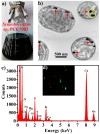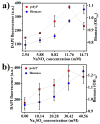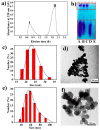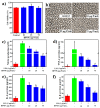Biogenic Polyphosphate Nanoparticles from a Marine Cyanobacterium Synechococcus sp. PCC 7002: Production, Characterization, and Anti-Inflammatory Properties In Vitro
- PMID: 30201855
- PMCID: PMC6163655
- DOI: 10.3390/md16090322
Biogenic Polyphosphate Nanoparticles from a Marine Cyanobacterium Synechococcus sp. PCC 7002: Production, Characterization, and Anti-Inflammatory Properties In Vitro
Abstract
Probiotic-derived polyphosphates have attracted interest as potential therapeutic agents to improve intestinal health. The current study discovered the intracellular accumulation of polyphosphates in a marine cyanobacterium Synechococcus sp. PCC 7002 as nano-sized granules. The maximum accumulation of polyphosphates in Synechococcus sp. PCC 7002 was found at the late logarithmic growth phase when the medium contained 0.74 mM of KH₂PO₄, 11.76 mM of NaNO₃, and 30.42 mM of Na₂SO₄. Biogenic polyphosphate nanoparticles (BPNPs) were obtained intact from the algae cells by hot water extraction, and were purified to remove the organic impurities by Sephadex G-100 gel filtration. By using 100 kDa ultrafiltration, BPNPs were fractionated into the larger and smaller populations with diameters ranging between 30⁻70 nm and 10⁻30 nm, respectively. 4',6-diamidino-2-phenylindole fluorescence and orthophosphate production revealed that a minor portion of BPNPs (about 14⁻18%) were degraded during simulated gastrointestinal digestion. In vitro studies using lipopolysaccharide-activated RAW264.7 cells showed that BPNPs inhibited cyclooxygenase-2, inducible nitric oxide (NO) synthase expression, and the production of proinflammatory mediators, including NO, tumor necrosis factor-α, interleukin-6, and interleukin-1β through suppressing the Toll-like receptor 4/NF-κB signaling pathway. Overall, there is promise in the use of the marine cyanobacterium Synechococcus sp. PCC 7002 to produce BPNPs, an anti-inflammatory postbiotic.
Keywords: Synechococcus sp. PCC 7002; Toll-like receptors; anti-inflammation; macrophages; polyphosphate nanoparticles.
Conflict of interest statement
The authors declare no conflicts of interest.
Figures







Similar articles
-
Biogenic Polyphosphate Nanoparticles from Synechococcus sp. PCC 7002 Exhibit Intestinal Protective Potential in Human Intestinal Epithelial Cells In Vitro and Murine Small Intestine Ex Vivo.J Agric Food Chem. 2018 Aug 1;66(30):8026-8035. doi: 10.1021/acs.jafc.8b03381. Epub 2018 Jul 19. J Agric Food Chem. 2018. PMID: 29975063
-
Protective effect of biogenic polyphosphate nanoparticles from Synechococcus sp. PCC 7002 on dextran sodium sulphate-induced colitis in mice.Food Funct. 2019 Feb 20;10(2):1007-1016. doi: 10.1039/c8fo01861h. Food Funct. 2019. PMID: 30706920
-
Overproduction, purification, and characterization of nanosized polyphosphate bodies from Synechococcus sp. PCC 7002.Microb Cell Fact. 2018 Feb 20;17(1):27. doi: 10.1186/s12934-018-0870-6. Microb Cell Fact. 2018. PMID: 29463242 Free PMC article.
-
Isotrifoliol inhibits pro-inflammatory mediators by suppression of TLR/NF-κB and TLR/MAPK signaling in LPS-induced RAW264.7 cells.Int Immunopharmacol. 2017 Apr;45:110-119. doi: 10.1016/j.intimp.2017.01.033. Epub 2017 Feb 10. Int Immunopharmacol. 2017. PMID: 28192731
-
Anti-inflammatory and anti-oxidant effect of Calea urticifolia lyophilized aqueous extract on lipopolysaccharide-stimulated RAW 264.7 macrophages.J Ethnopharmacol. 2016 Jul 21;188:266-74. doi: 10.1016/j.jep.2016.04.057. Epub 2016 Apr 30. J Ethnopharmacol. 2016. PMID: 27139571
Cited by
-
Probiotic Potential of the Marine Isolate Enterococcus faecium EA9 and In Vivo Evaluation of Its Antisepsis Action in Rats.Mar Drugs. 2023 Jan 7;21(1):45. doi: 10.3390/md21010045. Mar Drugs. 2023. PMID: 36662218 Free PMC article.
-
Long-Chain Polyphosphate Is a Potential Agent for Inducing Mucosal Healing of the Colon in Ulcerative Colitis.Clin Pharmacol Ther. 2020 Feb;107(2):452-461. doi: 10.1002/cpt.1628. Epub 2019 Nov 20. Clin Pharmacol Ther. 2020. PMID: 31513280 Free PMC article.
-
Polyphosphate: A Multifunctional Metabolite in Cyanobacteria and Algae.Front Plant Sci. 2020 Jun 26;11:938. doi: 10.3389/fpls.2020.00938. eCollection 2020. Front Plant Sci. 2020. PMID: 32670331 Free PMC article. Review.
-
Morphogenetic (Mucin Expression) as Well as Potential Anti-Corona Viral Activity of the Marine Secondary Metabolite Polyphosphate on A549 Cells.Mar Drugs. 2020 Dec 14;18(12):639. doi: 10.3390/md18120639. Mar Drugs. 2020. PMID: 33327522 Free PMC article.
-
Getting Grip on Phosphorus: Potential of Microalgae as a Vehicle for Sustainable Usage of This Macronutrient.Plants (Basel). 2024 Jul 3;13(13):1834. doi: 10.3390/plants13131834. Plants (Basel). 2024. PMID: 38999674 Free PMC article. Review.
References
-
- Kulaev I.S., Vagabov V.M., Kulakovskaya T.V. The Biochemistry of Inorganic Polyphosphates. Springer International Publishing; Cham, Switzerland: 2005. pp. 3–35.
-
- Bonting C.F.C., Kortstee G.J.J., Boekestein A., Zehnder A.J. The elemental composition dynamics of large polyphosphate granules in Acinetobacter strain 210A. Arch. Microbiol. 1993;159:428–434. doi: 10.1007/BF00288589. - DOI
-
- Racki L.R., Tocheva E.I., Dieterle M.G., Sullivan M.C., Jensen G.J., Newman D.K. Polyphosphate granule biogenesis is temporally and functionally tied to cell cycle exit during starvation in Pseudomonas aeruginosa. Proc. Natl. Acad. Sci. USA. 2017;114:E2440–E2449. doi: 10.1073/pnas.1615575114. - DOI - PMC - PubMed
MeSH terms
Substances
Grants and funding
LinkOut - more resources
Full Text Sources
Other Literature Sources
Research Materials

